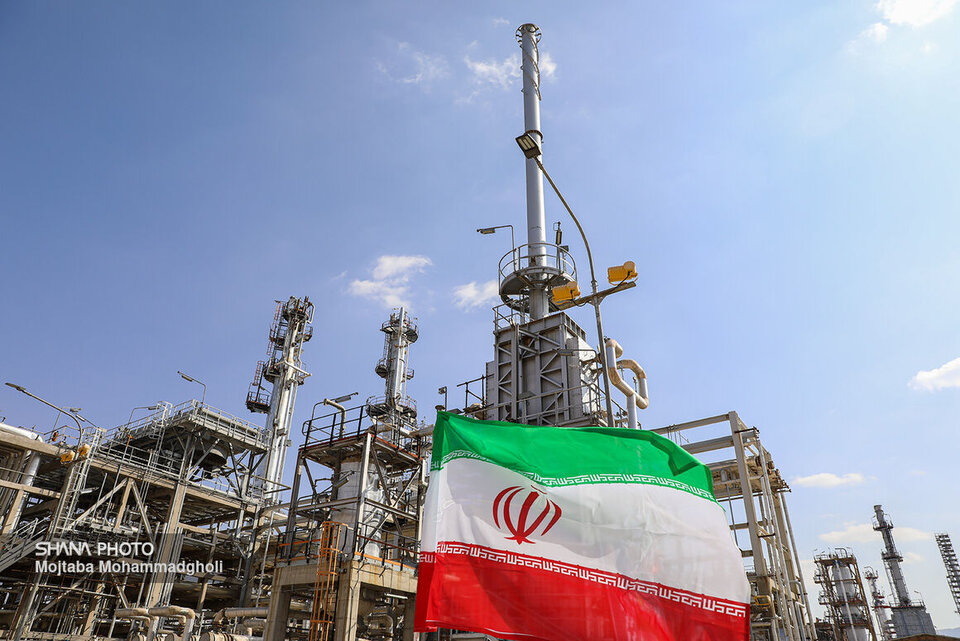These efforts have increased the production capacity of petroleum products using existing infrastructure and have notably curbed the growing imbalance in supply and demand. As the 46th anniversary of the Islamic Revolution approaches, it is an opportune time to review the progress of several refinery projects across the country.
Key completed projects include the launch of the Sulfur Recovery Unit (SRP) and Tail Gas Treatment (TGT) unit at the Tabriz Refinery, the isomerization unit at the Shiraz Refinery, the hydrocracking and hydrogen units in Phase 2 of the Abadan Refinery development project, the construction of an ammonia unit at the Persian Gulf Star Refinery, the breakthrough in needle coke production technology at the Shazand Refinery, and the establishment of a Residue Hydrotreating Unit (RHU) at the Isfahan Refinery.
Shiraz Refinery’s Isomerization Unit operational
In November, the Shiraz Refinery’s isomerization unit, with a capacity of 5,000 barrels per day, became operational. The unit aims to improve the quality of gasoline produced at the refinery, producing 1.6 million liters of Euro-grade gasoline daily.
The project seeks to increase gasoline production by 20%, raise the octane number from 87 to 91, reduce benzene content to below 1%, lower aromatic compounds to under 35%, decrease sulfur content to less than 2 ppm, and reduce environmental pollutants. The unit’s capacity is 795,000 liters per day, with current production at 540,000 liters daily. Once fully operational, it will produce 1.65 million liters of Euro 5 gasoline daily.
Breakthrough in needle coke production technology
The Shazand Refinery has achieved a breakthrough in needle coke production technology, a first for the country. The project comprises five main units, four of which were designed using domestic technology in collaboration with the Petroleum Industry Research Institute.
This technology, previously monopolized by a few international companies, marks a significant milestone for Iran’s refining sector. The project aims to eliminate heavy fuel oil and other polluting fuels from the refinery’s product portfolio, reduce sulfur dioxide emissions by 500 tons daily, and minimize environmental pollutants through the recovery of tail gases.
Ammonia Unit construction at Persian Gulf Star Refinery
The Persian Gulf Star Refinery, one of the country’s most critical refineries, processes 450,000 barrels of gas condensates daily, producing 45 liters of gasoline, 10.5 million liters of diesel, 1,800 tons of liquefied gas, 4 million liters of kerosene, and various solvents, hydrogen, sulfur, and residue.
To prevent the waste of hydrogen gas and other hydrocarbons, which are currently flared, the refinery has initiated the construction of an ammonia unit. The project has received preliminary approval, and contracts for technical studies, basic design, and procurement are underway.
Increased Diesel Production at Tabriz Refinery
Four projects—diesel purification, hydrogen purification (PSA), sulfur recovery (SRP), and tail gas treatment (TGT)—have been completed at the Tabriz Refinery with an investment of over €120 million.
These projects, executed using domestic contractors and consultants, will increase the refinery’s Euro 5 diesel production from 2 million to 3 million liters daily. Other goals include producing high-purity hydrogen, recovering 110 tons of sulfur daily, and reducing sulfur dioxide emissions and environmental pollutants in Tabriz.
Boost in gasoline production at Isfahan Refinery
The Isfahan Refinery, one of the largest and most advanced in the country, supplies 23% of Iran’s fuel. It plays a crucial role in providing gasoline and diesel to 17 provinces. To address fuel imbalances, particularly in northern and eastern provinces, the National Iranian Oil Refining and Distribution Company has prioritized increasing gasoline production at the Isfahan Refinery.
The refinery’s daily gasoline production has risen from 12.5 million to 14.5 million liters, with further upgrades planned to increase processing capacity from 370,000 to 390,000 barrels per day.
Hydrocracking Unit launched at Abadan Refinery
The largest hydrocracking unit in West Asia, with a daily capacity of 42,000 barrels, has been commissioned at the Abadan Refinery as part of its Phase 2 development project.
The unit produces environmentally friendly, high-value products, including liquefied gas, heavy and light naphtha, jet fuel, and Euro 5 diesel. The project reduces heavy fuel oil production by 42,000 barrels daily and diversifies the refinery’s product portfolio.
Environmental measures include the installation of sulfur recovery units and advanced safety equipment.
Environmental initiatives
Environmental projects aimed at reducing air pollution are being actively pursued across refineries. Key projects include the construction of tail gas treatment units at the Shiraz and Tabriz refineries, the installation of flare gas recovery systems, and the implementation of online monitoring systems for emissions.
These initiatives are part of a broader effort to align Iran’s refining sector with international environmental standards.
Progress on RHU Project at Isfahan Refinery
The Residue Hydrotreating Unit (RHU) project at the Isfahan Refinery, aimed at addressing fuel imbalances, is 65% complete. The project, which began in 2019, is expected to be partially operational by mid-2025.
It will significantly reduce sulfur content in heavy fuel residues, from 30,000 ppm to below 5,000 ppm, contributing to cleaner air in Isfahan and other cities.
Financial challenges and prioritization
Due to financial constraints caused by international factors and previous mismanagement, refineries are prioritizing projects based on available budgets. The Isfahan Refinery, for instance, is focusing on completing the RHU project while ensuring the payment of dividends, employee salaries, and other operational expenses.
These developments underscore Iran’s commitment to modernizing its refining sector, improving product quality, and reducing environmental impact.


Your Comment